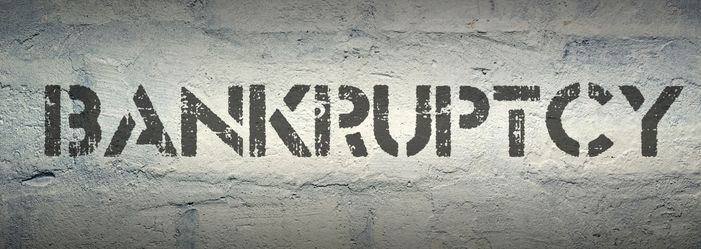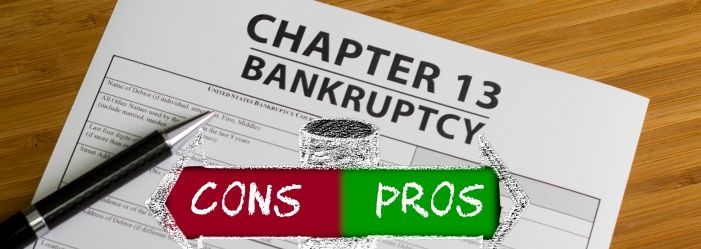Last Updated: March 19, 2024
Learn about chapter 13 bankruptcy

Disclaimer: We are not qualified bankruptcy professionals and are not giving advice. Always speak with a qualified professional before making any legal or financial decisions.
Facing financial turmoil can feel like navigating a storm without a compass. If you're overwhelmed by debt but wish to avoid the total wipeout of bankruptcy, Chapter 13 might be your beacon of hope.
Often referred to as the wage earner's plan, Chapter 13 bankruptcy allows individuals with a steady income to reorganize their debts, offering a path to financial recovery without losing everything.
In this guide, we'll simplify Chapter 13, providing you with the essentials to understand how it works and how it might be the lifeline you need.
Eager to skip the details and get advice from a debt professional now? Click here for a free consultation.
Chapter 13 Bankruptcy
Chapter 13 is a reorganization of debt rather than an erasure of debt. There is a limit as to how much debt you can have with Chapter 13, and it takes at least up to five years to get a discharge.
The main benefit of Chapter 13 is that it allows debtors to keep the property and catch up on non-dischargeable debt payments like mortgages and car loans.
The main benefit to Chapter 13 is that you do not lose your property and it allows you to play catch up on bills. You also do not end up with as much damage to your credit report with Chapter 13.
How does Chapter 13 Work?
Basically, your first step to a Chapter 13 bankruptcy case is complete a credit counseling course (this costs between $10 and $50). Once this is completed, you fill out all 23 required Chapter 13 bankruptcy relief forms and sign the appropriate pages, you then file a bankruptcy petition with the bankruptcy court. This costs $313, and bankruptcy filings are not waivable.
You will also create and submit a Chapter 13 repayment plan with the Chapter 13 forms.
You will be assigned a court-appointed trustee who will go over your paperwork and the bankruptcy forms to make certain you filled out both accurately.
You will then have a 341 meeting with the creditors and bankruptcy trustee.
The next step in the Chapter 13 bankruptcy process is a hearing before the bankruptcy judge who will decide if your case is valid.
If the bankruptcy court approves your petition, you then complete your Chapter 13 bankruptcy plan and make all payments on time.
Your final step before discharge is a second credit counseling class. If you have completed your debt management plan, your Chapter 13 bankruptcy is then discharged.
Read here to learn more about Bankruptcy information
Pros and Cons of Chapter 13

Pros of Chapter 13:
Keep Property
Chapter 13 permits debtors to keep assets like a home, car, or other property while repaying debts over time through a court-approved repayment plan. This can stop foreclosure or repossession.
Stop Collection Efforts
Once a Chapter 13 case is filed, creditors must cease collection efforts and contact the trustee instead. This provides relief from harassment by creditors.
Reduce Unsecured Debt
Unsecured debts like credit cards, medical bills, and personal loans can be paid back at a fraction of what is owed, often as little as 25% of the total debt. This can significantly reduce or eliminate unsecured debts.
Catch Up on Mortgage/Car Payments
Chapter 13 allows debtors to become current on missed secured debt payments like mortgages and car loans by making up the missed payments over the 3-5-year repayment period. This avoids foreclosure or repossession.
Cons of Chapter 13:
Lengthy Repayment Period
Chapter 13 plans typically last from 36-60 months. This is a long period during which all disposable income must go toward repaying debts.
Credit Damage
A Chapter 13 bankruptcy remains on your credit report for 7 years from the date of discharge, damaging credit and making loans difficult to obtain.
Secured Debts Must Be Paid
All missed payments on secured debts like mortgages and car loans must be made up over the life of the plan. The full amounts of these debts must be repaid.
Liquidation of Asset
While not required, the trustee may force the liquidation of certain assets to repay creditors. Equity in luxury items or second homes may need to be tapped.
Risk of Dismissal
If the debtor fails to make payments on time or comply with the court-ordered repayment plan, the case can be dismissed, eliminating bankruptcy protections.
Alternatives to Chapter 13 Bankruptcy
Chapter 13 bankruptcy is their best option:
Debt Management Plan
Work with a non-profit credit counseling agency to set up a debt management plan (DMP) that allows you to consolidate debts into one payment each month, often with reduced or waived interest rates and fees. A DMP helps get accounts current and pay down principal balances over 3-5 years.
Debt Settlement
A debt settlement company negotiates directly with your creditors to settle accounts for on average 40-60% less than the total amount owed. This does damage credit but lets you avoid bankruptcy.
Debt Consolidation Loan
Take out a new personal loan to pay off higher-interest credit card balances. This simplifies payments into one bill at a lower interest rate. Credit score determines loan terms.
Selling Assets
Liquidating assets like a second car, valuable collectibles, real estate, or other property can generate funds to pay off debts and avoid bankruptcy altogether.
Budgeting Assistance
Get help from a credit counseling agency or financial advisor to create a realistic budget that prioritizes debt payments and living expenses. This helps manage payments.
Debt and Chapter 13 Bankruptcy Court
As of 2021, you can file for Chapter 13 if you have less than $419,275 in unsecured debts including medical bills, personal loans, utility bills, and credit card debt.
Your secured debt (mortgage, home equity loans, and car loans) can not exceed $1,257,850 with a Chapter 13. The main difference between secured debt and unsecured debt is unsecured debts usually included credit cards, medical bills, and student loans.
Certain priority debts are not dischargeable in Chapter 13. These secured and unsecured debts include the following:
- tax debt or government fees
- mortgages
- child support obligations or alimony
- any student loan debt
- any car loan
For a broader understanding of what declaring bankruptcy entails in terms of debt elimination, you might want to explore our article on whether you get out of all debts if you declare bankruptcy.
Chapter 13 and Property
Under Chapter 7, you can be required to sell most assets like property in order to repay debt. Under Chapter 13. you can keep the property but must pay up to that appraised amount to creditors.
Chapter 13 Payment Calculator
If Chapter 13 sounds like a possible option, you may want to try out a Chapter 13 Bankruptcy payment calculator. You will need to gather a lot of information before you can make an informed decision.
The easiest way to find a Chapter 13 calculator is to open up Google and search the words "chapter 13 payment calculator".
Priority Debts
If you have priority debt like child support, alimony, or tax debt, you need to pay these in full during your Chapter 13 bankruptcy repayment plans. You'll need to know the value of these debts.
Mortgage Payments
If you want to keep your home, you will have to pay off any outstanding amount (in arrears) during the repayment plan.
If you plan to surrender the home, you do not pay back the arrears.
If you have home equity loans or a HELOC, you have several options with a Chapter 13 and may be able to lien strip them. Since this can be very complicated, speak to a bankruptcy lawyer.
Car Loan and other Secured Debt
If you have non-mortgage secured debts, you generally have to pay off loans during a Chapter 13 bankruptcy. You'll need to know how much you owe and enter the values in the correct sections.
If you qualify for a "cramdown" you may end up paying the actual value of the vehicle, not the owed value. Again, you may want to speak with a specialized Chapter 13 Bankruptcy attorney.
Administrative Fees
For a Chapter 13 BK, you will generally have to pay the court-appointed trustee up to 10% of all amounts distributed to unsecured creditors.
You may also have to pay interest on secured debts that you are paying off through your debt management plan. This totals prime rate plus 1-3%.
Legal Fees
Chapter 13 is far more complicated than chapter 7 so you may want to hire a bankruptcy lawyer. The cost can be rolled into your payment plan.
Rebuilding Credit After Chapter 13
Once a Chapter 13 case has been discharged, focus on how to rebuild your credit score.
Get a Secured Credit Card
Secured cards require a cash deposit that acts as your credit limit. Responsible use demonstrates you can handle credit again.
Become an Authorized User
Ask a family member with good credit to add you as an authorized user on a credit card. Their positive history boosts your score.
Pay Bills On Time
Pay all bills, including utilities and rent, by their due dates. This responsibly shows creditors you can meet obligations.
Limit New Credit
Hold off applying for new credit until your score starts to recover. Too many new accounts can hurt scores.
Monitor Credit Reports
Review reports from Equifax, Experian, and TransUnion. Dispute any errors by submitting proof to the credit bureaus.
Consider a Credit-Builder Loan
These loans place the amount borrowed in a savings account. Small monthly payments and interest build credit history.
FAQs
Other Options for Bankruptcy Proceedings
There are options to bankruptcy court to obtain financial relief. Before you file a Chapter 13 bankruptcy, consider talking to the debt relief professionals at Pacific Debt Relief. We specialize in debt settlement for unsecured debt like medical bills and outstanding credit card debt.
We may be able to help you settle your consumer debt for substantially less than you owe and succeed with a debt repayment plan. We do not require a consolidation loan or any personal loans.
There are consequences to debt settlement, but settling can be a better option than bankruptcy. Our debt relief experts are standing by to help you understand all your debt relief options and if debt settlement is not right for you, can refer you to a trusted partner who can help you improve your financial situation.
Conclusion
While Chapter 13 bankruptcy can provide debt relief by allowing you to repay debts over time, it has serious downsides like lengthy repayment plans and credit damage. Thoroughly explore all alternatives first, like debt management plans, debt settlement, and budgeting assistance.
The decision to file Chapter 13 should not be taken lightly. However, if you responsibly follow through with your repayment plan and take steps to rebuild credit after discharge, financial recovery is possible.
With time and diligent money management, you can bounce back from Chapter 13 bankruptcy and work toward restoring your financial health. The process is difficult, but take it one step at a time.
If you are struggling with overwhelming debt and want to explore your debt relief options, Pacific Debt Relief offers a free consultation to assess your financial situation. Our debt specialists can provide objective guidance relevant information and support to help find the right debt relief solution.
Disclaimer: We are not offering advice on bankruptcy law. Contact a bankruptcy attorney for more information.
✔ Accredited by Better Business Bureau with BBB A+ rating (4.93 rating and 1678 reviews)
✔ US News and World Reports and Bankrate ranked Pacific Debt Relief as one of “The Best Debt Relief Companies of 2024”
✔ 6.9 star rating by BestCompany.com (over 2379 client reviews)
✔ 4.8 star rating by TrustPilot based (over 1613 verified consumer reviews)
✔ ConsumerAffairs.com Accredited (over 544 verified reviews with an average rating of 5 stars)
✔ A Top 10 Rated Compan by TopTenReviews.com , ConsumersAdvocate.com and Top10debtconsolidation.com
✔ 4.6 star rating by Google (229 client reviews)
✔ 100% rating by SuperMoney (9 client reviews)
Reduce Your Credit Card Debt By Up to Half

BBB Reviews | 4.9/5.0 Rating









 Do Not Sell My Personal Information
Do Not Sell My Personal Information